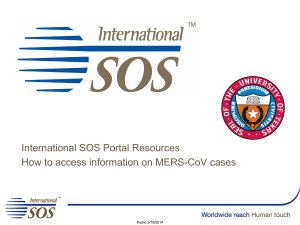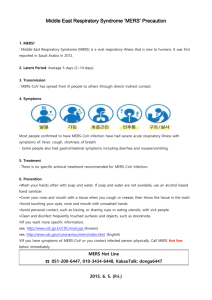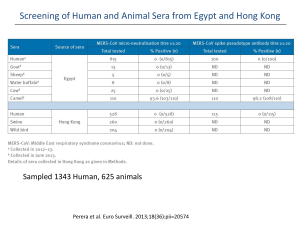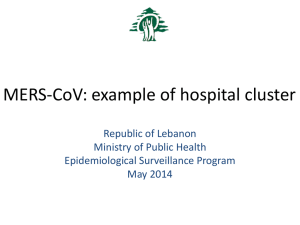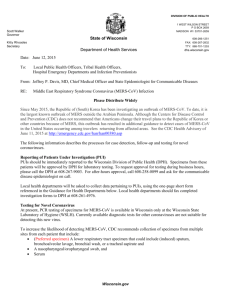Middle East respiratory syndrome coronavirus in children
advertisement
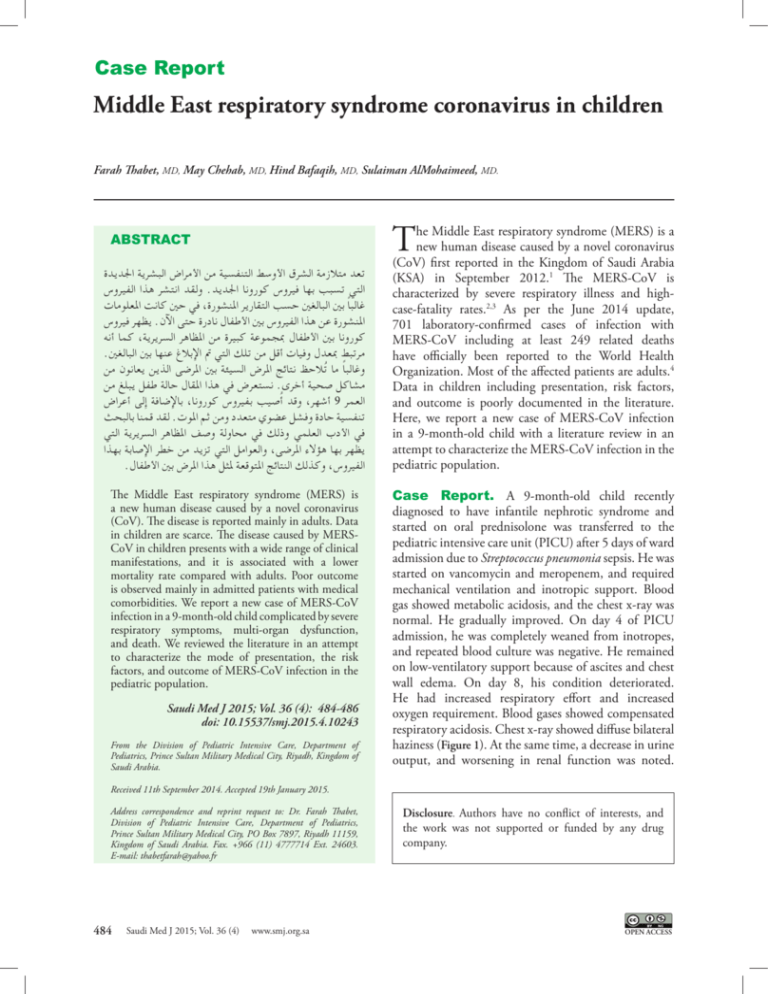
Case Report Middle East respiratory syndrome coronavirus in children Farah Thabet, MD, May Chehab, MD, Hind Bafaqih, MD, Sulaiman AlMohaimeed, MD. ABSTRACT تعد متالزمة الشرق األوسط التنفسية من األمراض البشرية اجلديدة ولقد انتشر هذا الفيروس.التي تسبب بها فيروس كورونا اجلديد في حني كانت املعلومات،غالب ًا بني البالغني حسب التقارير املنشورة يظهر فيروس.املنشورة عن هذا الفيروس بني األطفال نادرة حتى اآلن كما أنه،كورونا بني األطفال مبجموعة كبيرة من املظاهر السريرية .مرتبط مبعدل وفيات أقل من تلك التي مت اإلبالغ عنها بني البالغني وغالب ًا ما تُالحظ نتائج املرض السيئة بني املرضى الذين يعانون من نستعرض في هذا املقال حالة طفل يبلغ من.مشاكل صحية أخرى باإلضافة إلى أعراض، وقد ُأصيب بفيروس كورونا، أشهر9 العمر لقد قمنا بالبحث.تنفسية حادة وفشل عضوي متعدد ومن ثم املوت في األدب العلمي وذلك في محاولة وصف املظاهر السريرية التي والعوامل التي تزيد من خطر اإلصابة بهذا،يظهر بها هؤالء املرضى . وكذلك النتائج املتوقعة ملثل هذا املرض بني األطفال،الفيروس The Middle East respiratory syndrome (MERS) is a new human disease caused by a novel coronavirus (CoV). The disease is reported mainly in adults. Data in children are scarce. The disease caused by MERSCoV in children presents with a wide range of clinical manifestations, and it is associated with a lower mortality rate compared with adults. Poor outcome is observed mainly in admitted patients with medical comorbidities. We report a new case of MERS-CoV infection in a 9-month-old child complicated by severe respiratory symptoms, multi-organ dysfunction, and death. We reviewed the literature in an attempt to characterize the mode of presentation, the risk factors, and outcome of MERS-CoV infection in the pediatric population. Saudi Med J 2015; Vol. 36 (4): 484-486 doi: 10.15537/smj.2015.4.10243 From the Division of Pediatric Intensive Care, Department of Pediatrics, Prince Sultan Military Medical City, Riyadh, Kingdom of Saudi Arabia. T he Middle East respiratory syndrome (MERS) is a new human disease caused by a novel coronavirus (CoV) first reported in the Kingdom of Saudi Arabia (KSA) in September 2012.1 The MERS-CoV is characterized by severe respiratory illness and highcase-fatality rates.2,3 As per the June 2014 update, 701 laboratory-confirmed cases of infection with MERS-CoV including at least 249 related deaths have officially been reported to the World Health Organization. Most of the affected patients are adults.4 Data in children including presentation, risk factors, and outcome is poorly documented in the literature. Here, we report a new case of MERS-CoV infection in a 9-month-old child with a literature review in an attempt to characterize the MERS-CoV infection in the pediatric population. Case Report. A 9-month-old child recently diagnosed to have infantile nephrotic syndrome and started on oral prednisolone was transferred to the pediatric intensive care unit (PICU) after 5 days of ward admission due to Streptococcus pneumonia sepsis. He was started on vancomycin and meropenem, and required mechanical ventilation and inotropic support. Blood gas showed metabolic acidosis, and the chest x-ray was normal. He gradually improved. On day 4 of PICU admission, he was completely weaned from inotropes, and repeated blood culture was negative. He remained on low-ventilatory support because of ascites and chest wall edema. On day 8, his condition deteriorated. He had increased respiratory effort and increased oxygen requirement. Blood gases showed compensated respiratory acidosis. Chest x-ray showed diffuse bilateral haziness (Figure 1). At the same time, a decrease in urine output, and worsening in renal function was noted. Received 11th September 2014. Accepted 19th January 2015. Address correspondence and reprint request to: Dr. Farah Thabet, Division of Pediatric Intensive Care, Department of Pediatrics, Prince Sultan Military Medical City, PO Box 7897, Riyadh 11159, Kingdom of Saudi Arabia. Fax. +966 (11) 4777714 Ext. 24603. E-mail: thabetfarah@yahoo.fr 484 Saudi Med J 2015; Vol. 36 (4) www.smj.org.sa Disclosure. Authors have no conflict of interests, and the work was not supported or funded by any drug company. OPEN ACCESS Coronavirus and children ... Thabet et al output and worsening renal failure, but he continued to deteriorate, and died 4 days later. No other explanation for the sudden deterioration of the patient could be identified. We could not determine the source of infection in our patient despite extensive investigations, including screening of the healthcare providers who came in contact with the patient in the emergency department, in the pediatric ward, and the PICU, as well as, all the family contact members. Figure 1 - Chest x-ray with bilateral chest infiltration in a 9-month-old child. Echocardiography showed mild tricuspid regurgitation with normal cardiac function. He was switched to highfrequency oscillatory ventilation. He was afebrile, and laboratory investigations showed a C-reactive protein of 24 mg/L (normal value [NV] - 0-6 mg/L), white blood cell count of 9.600/mm3 (NV - 5-14.5/mm3), hemoglobin of 10.9 g/dL (NV - 11.5-15.5 g/dl), and platelet of 32000/mm3 (NV - 150-450/mm3). His coagulation profile was initially within the normal range but later become prolonged (prothrombin time [PT] - 25 sec [NV - 11.5-14.5 s]; international normalized ratio [INR - 2.4 [NV - 0.9-1.3], prothrombin time [PTT] - 78 sec [NV - 30-41 s], fibrinogen - 5.2 g/ dL [NV - 2-4 g/L]), and repeated blood culture was negative). Tracheal aspirate was positive by real-time polymerase chain reaction (RT-PCR). Amplification of both the upstream E protein (UpE gene) for screening and open reading frame (ORF)1a for confirmation of MERS-CoV. He continued to receive supportive treatment and was started on continuous renal replacement therapy due to decreased urine Discussion. Since the emergence of MERS-CoV, the Prince Sultan Military Medical City in Riyadh has taken extensive measures (the “no risk” policy) to prevent further spread of the disease. Apart from extensive infection control measures, a vast education campaign for the staff and the community including parents and their children was initiated. In compliance with the Saudi Arabian Ministry of Health recommendations, screening with PCR for MERS-CoV was carried out for every patient that presented or developed fever, and respiratory symptoms with new chest infiltration documented on the chest x-ray. Despite all this extensive screening, and in contrast to what was observed by our colleagues dealing with adult cases in the hospital, our pediatric department could identify only one case of MERS-CoV in a 9-month-old child known to have nephrotic syndrome. Furthermore, out of 701 patients confirmed MERS-CoV reported, so far worldwide, only 14 were pediatric cases (2%).4 Does this mean that MERS-CoV is mainly an adult disease? Or alternatively, does MERS-CoV in children have a different clinical picture, including a less severe disease, or an atypical presentation, or even an asymptomatic carrier state? What are the risk factors, the comorbidities and the outcome? These questions are still unanswered in the pediatric literature. The 14 children with Table 1 - Summary of reported pediatric cases with confirmed Middle East respiratory syndrome-coronavirus in the literature. Patient Reference Age Gender Symptoms 1 Our patient Male Severe respiratory distress 2 3 Family contact6 Inpatient7 9-monthold 8-year-old 4-year-old 4 Inpatient5 2-year-old Male 5 Inpatient5 14-year-old Female 6-14 Family contact4 Male Male 3-16-year- 2 males, olds 7 females Co-morbidities Chest x- ray Infantile nephrotic syndrome Mild respiratory symptoms No Mild respiratory symptoms No Fever, severe respiratory distress Fever Cystic fibrosis Down’s syndrome None No Intensive care unit Yes Bilateral diffuse infiltrate Not documented No Not documented Not documented Bilateral diffuse infiltrate Bilateral diffuse infiltrate Not done www.smj.org.sa Outcomes Died Survived Survived Yes Died No Survived No Survived Saudi Med J 2015; Vol. 36 (4) 485 Coronavirus and children ... Thabet et al confirmed MERS-CoV have a mean age of 99 months, and they were 8 females and 6 males (Table 1). Nine patients were asymptomatic and were detected during screening of family contact; all these 9 patients were healthy without underlying diseases.5 Three patients developed mild respiratory symptoms,5-7 while the last 2 patients developed severe respiratory symptoms.5 These 2 patients have associated comorbidities. The outcome was good in 12 patients, while the 2 patients with severe respiratory symptoms and comorbidities developed multi-organs dysfunction and died (14.2%). It is interesting to note that similar to adults, pediatric patients with poorer outcome develop multi-organ impairment, and mainly renal failure.8 From this small series, compared to adult patients, MERS-CoV in children is less frequent and seems to be associated with less mortality unless the patient has underlying comorbidities. This impression of low mortality in children with MERS-CoV was also reported during the acute respiratory syndrome coronavirus (SARS-CoV) infections in children, where symptoms were milder, and resulted in no mortality, and few hospitalizations.9 The low incidence of MERS-CoV infection in children is corroborated by a Jordanian prospective year-round viral surveillance study in children less than 2 years of age admitted with acute respiratory symptoms and/ or fever from March to September 2010 tested for MERS-CoV, all 474 tested patients were negative.10 We were, unfortunately, unable to identify how our patient got infected. Three patterns of transmission of the disease are suggested by the literature:11 the first pattern is the occurrence of sporadic cases in communities. The true incidence of the disease in the community is not known. The second pattern is transmission within families. The rate of intrafamilial transmission is not known, but it is estimated to be approximately 3.6%.10 The third transmission pattern is nosocomial transmission from patient to patient, or from a patient to healthcare provider, or vice versa The study by Memish et al11 reported a positivity rate of MERS-CoV by PCR of only 1.12% of all tested health care workers. These data suggest that the recommended infection control measures are adequate to reduce the risk of transmission within healthcare facilities. During our investigations, we focused on the last 2 patterns of transmission, and we searched for any link between our patient and adult patients admitted during the same period with MERS-CoV in our hospital, however we failed to demonstrate any positive contacts. 486 Saudi Med J 2015; Vol. 36 (4) www.smj.org.sa In conclusion, these data indicate that although few cases of MERS-CoV in children have been detected, it remains mainly a disease of adults. The disease caused by MERS-CoV in children presents with a wide range of clinical manifestations, and it is associated with a lower mortality rate compared with adults. Poor outcome is observed mainly in admitted patients with medical comorbidities. References 1. Zaki AM, Van Boheemen S, Bestebroer TM, Osterhaus AD, Fouchier RA. Isolation of a novel coronavirus from a man with pneumonia in Saudi Arabia. N Engl J Med 2012; 367: 1814-1820. 2. Assiri A, Al-Tawfiq JA, Al-Rabeeah AA, Al-Rabiah FA, Al-Hajjar S, Al-Barrak A, et al. Epidemiological, demographic, and clinical characteristics of 47 cases of Middle East respiratory syndrome coronavirus disease from Saudi Arabia: a descriptive study. Lancet Infect Dis 2013; 13: 752-761. 3. Assiri A, McGeer A, Perl TM, Price CS, Al Rabeeah AA, Cummings DA, et al. Hospital outbreak of Middle East respiratory syndrome coronavirus. N Engl J Med 2013; 369: 407-416. 4. World Health Organization. Middle East respiratory syndrome coronavirus (MERS-CoV) update. [Updated 2014 June 13] Geneva (CH): World Health Organization; 2014. Available from: http://www.who.int/csr/don/2014_06_16/en/ 5. Memish ZA, Al-Tawfiq JA, Assiri A, AlRabiah FA, Al Hajjar S, Albarrak A, et al. Middle East respiratory syndrome coronavirus disease in children. Pediatr Infect Dis J 2014; 33: 904-906. 6. World Health Organization. Middle East respiratory syndrome coronavirus (MERS-CoV) - update. [Updated 2014 Dec 2] Geneva (CH): World Health Organization; 2013. Available from: http://www.who.int/csr/don/2013_12_02/en/ 7. World Health Organization. Middle East respiratory syndrome coronavirus (MERS-CoV) - update. [Updated 2014 April 26] Geneva (CH): World Health Organization; 2014. Available from: http://www.who.int/csr/don/2014_04_26_mers/en/ 8. Arabi YM, Arifi AA, Balkhy HH, Najm H, Aldawood AS, Ghabashi A, et al. Clinical course and outcomes of critically ill patients with Middle East respiratory syndrome coronavirus infection. Ann Intern Med 2014; 160: 389-397. 9. Denison MR. Severe acute respiratory syndrome coronavirus pathogenesis, disease and vaccines: an update. Pediatr Infect Dis 2004; 11: 207-214. 10. Khuri-Bulos N, Payne DC, Lu X, Erdman D, Wang L, Faouri S, et al. Middle East respiratory syndrome coronavirus not detected in children hospitalized with acute respiratory illness in Amman, Jordan, March 2010 to September 2012. Clin Microbiol Infect 2014; 20: 678-682. 11. Memish ZA, Al-Tawfiq JA, Makhdoom HQ, Al-Rabeeah AA, Assiri A, Alhakeem RF, et al. Screening for Middle East respiratory syndrome coronavirus infection in hospital patients and their healthcare worker and family contacts: a prospective descriptive study. Clin Microbiol Infect 2014; 20: 469-474.
